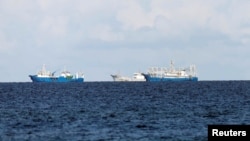A wind turbine installation vessel, developed in China for use near its coasts, is sparking new hope that the dominant party in a six-way maritime sovereignty dispute will share technology. But analysts warn Beijing seldom brings in outsiders.
The Chinese government has a wide technological lead in the South China Sea sovereignty dispute with Taiwan and four Southeast Asian countries. Its arsenal includes a bathyscaphe, the discovery of an ice-like fuel under the seabed and plans to install an ocean observation network. Beijing also dominates five other governments in military control of the disputed South China Sea.
The deployment Sunday of the Longyuan Zhenhua 3 wind-harnessing vessel could help passing ships and “boost international cooperation,” a National Institute for the South China Sea research fellow was quoted as saying in Chinese state-controlled media.
“At the same time you use that (technology) for military defense in the South China Sea, then you can tell other people that ‘I’m contributing data for the greater good of mankind,’” said Collin Koh, a maritime security research fellow at Nanyang Technological University in Singapore.
Because of sensitivities about the scope of its claim to most of the 3.5 million-square-kilometer sea, experts say China seldom shares much despite periodic statements about involving other countries. Other countries may resist as well.
“It is something like tacit acquiescence or acknowledgement of China’s dominance and recognizing that you are using its goods and thereby you are recognizing that it has control,” Koh said.
Pledges to cooperate
The wind-harnessing vessel is just the most recent example of China hinting at cooperation, which would help it be seen as a good neighbor.
In May, China’s official Xinhua News Agency quoted a government source calling the discovery of combustible ice, an energy source that turned up under the South China Sea after two decades of research, a way to “help resolve the energy resource problem and boost economic development and exchanges between countries.”
A government document carried by Xinhua in June heralded a “blue partnership” and called for Sino-foreign maritime cooperation to “jointly tackle challenges and crises, thus promoting regional peace and stability.”
But aside from helping to supply foreign-registered cargo ships, China hasn’t shared much more, said Yun Sun, East Asia Program senior associate at the Stimson Center think tank in Washington.
“I haven’t seen precedent so far, but I think that’s how the Chinese portray their buildups in the South China Sea, that these civilian facilities, civilian equipment could someday be treated as an international public good,” Sun said. “I think that’s how they portray it, justify it -- just haven’t seen specific examples of where the Chinese have welcomed other countries to use what they have.”
China has the tools to detect the activity of other countries around the sea with advanced technology such as radar, aerial drones and a satellite covering parts of the sea’s Paracel and Spratly island chains.
Other countries lack the budget or expertise to vie with China’s maritime technology. Brunei, Malaysia, the Philippines and Vietnam all claim parts of the South China Sea that overlap a tract China calls its own. China’s claim covers about 90 percent of the sea between its south coast and the island of Borneo.
Barriers to Sino-foreign sharing
China may avoid sharing in part because its technology is too new to offer "junior partners" without losing its innovative edge, said Fabrizio Bozzato, a Taiwan Strategy Research Association fellow Southeast Asia. Some of its discoveries are aimed at extracting fuel and fish from the sea, which is also one of the world’s major shipping lanes.
Scientists, he said, may say “nice things” following breakthroughs, but policymakers will later realize the technology is better off withheld, particularly for military use.
“The technology is actually a leap forward in China’s implementation of a sophisticated logistical support system, so I believe it’s quite unlikely that China is willing to share that technology with partner nations,” Bozzato said.
Beijing may ultimately feel comfortable sharing non-sensitive data, such as on the marine environment, in parts of the sea that other countries do not challenge, Koh said.
But he added that it would not want other countries to get any data on islets that it holds in the South China Sea.
Other countries run a risk
Southeast Asian nations for their own part may prefer to avoid joint use of Chinese marine technology in disputed waters, analysts say. Their involvement could imply acceptance of China’s sovereignty claims, a perception that would face public opposition in Vietnam and the Philippines.
“For any player in the region it would be naïve to share technology with a competitor,” Bozzato said.
Search and rescue cooperation using Chinese gear risks the arrest of any foreign nationals who are saved, Sun said. “Will they be released or will they be put in a Chinese jail?” she asked.







